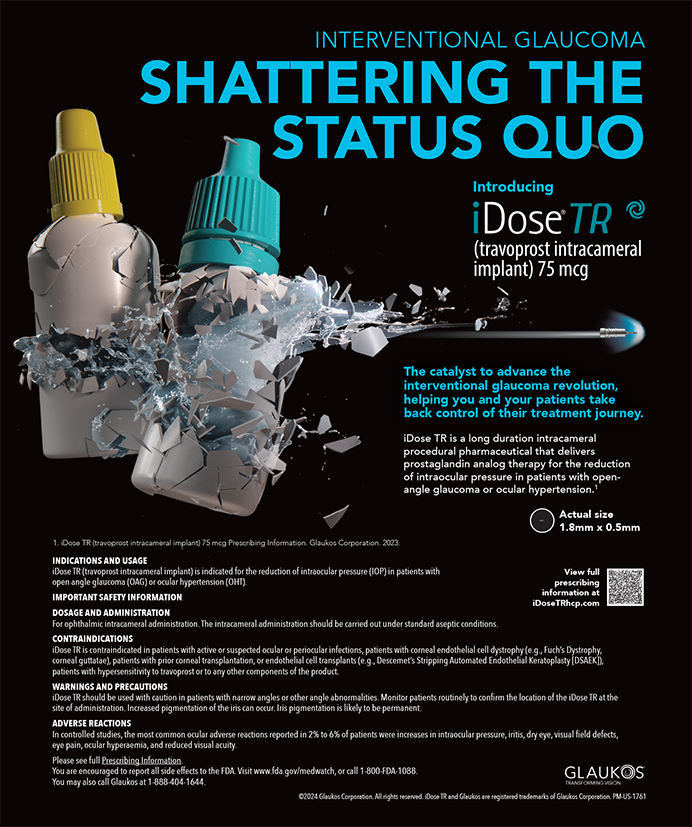CASE PRESENTATION
A 75-year-old white male recently underwent clear corneal cataract extraction. The patient's ocular history included a prior nd:YAG laser peripheral iridectomy, a shallow anterior chamber, and a 5.0-mm, maximally dilated pupil.
The procedure, performed under a topical and intracameral injection of 1% lidocaine, began as a clear corneal hinge incision with a 2.0-mm tunnel length. Prior to capsulorhexis, viscoelastic material was injected into the anterior chamber, resulting in iris prolapse.
1. How would you handle the iris prolapse?
2. How would you perform capsulorhexis?
3. How would you perform hydrodissection?
4. How would you perform phacoemulsification?
SURGICAL COURSE
Those of us who have encountered iris prolapse know that it can be more than just a nuisance. It can lead to complications, because once the iris prolapses, it can continue to prolapse throughout the case. Iris prolapse occurs 1) when the pupil is small (4.0 to 5.0 mm), 2) when a small pupil requires stretching, or 3) when a small pupil, secondary to posterior synechiae, requires stretching leading to a flaccid pupil.
For iris prolapse to occur, the rim of the iris must be anterior to the distal end of the corneal tunnel (Figure 1). The surgeon injects viscoelastic material or saline into the anterior chamber, hyperinflating the anterior chamber (Figure 2). The viscoelastic material or saline flows along the floor of the anterior lens surface, traveling beneath the iris. Then, the viscoelastic material or saline elevates the iris, pushes it anteriorly, and propels it into the corneal tunnel.
OUTCOME
Some of the consequences of iris prolapse are 1) replacing the iris into the anterior chamber usually results in repeat iris prolapse, 2) repeat iris prolapse leads to the iris being torn, frayed, and flaccid often requiring iris reconstruction, and 3) trying to perform phacoemulsification after repositioning the iris leads to the iris being sucked into the phaco tip giving it a frayed, traumatized, chewed-up look at the end of the procedure.
I decided that a safer way to handle iris prolapse is to create a paracentesis that forms a second tunnel next to the first (Figure 3). I added just enough viscoelastic material to perform capsulorhexis. I did not hydrosdissect, nor did I rotate the lens for fear that the lens may have adhesions to the posterior capsule and tear the capsule.
I proceeded to perform phacoemulsification, and constructed a deep groove. I fractured the lens into two halves. Since there was less bulk in the anterior chamber, viscoelastic material could now be used at the base of the groove to dissect the lens from the posterior capsule. One half of the lens was elevated and emulsified out, followed by the other half. Irrigation-aspiration removed the remaining cortical material. I used viscoelastic material to fill the bag, and placed an IOL into the bag. Replacing the the iris into the anterior chamber using a round spatula was performed with ease.
The procedure went very well and I experienced no complications. The patient's pupil was round and had a normal appearance. Key points to remember are 1) do not overinflate the anterior chamber, 2) if you suspect prolapse, inject viscoelastic material proximally first and then distally, 3) if you anticipate or suspect that iris prolapse might occur, open the side port as an escape valve thus avoiding overinflation, and 4) if the aforementioned solutions fail, create a second tunnel next to the first tunnel.
David Langerman, MD, FACS, is the Director of the Langerman Eye Institute & Laser Vision Center, in Orangeburg, New York. Text extracted from the Video Journal of Cataract and Refractive Surgery, Volume XVII, Issue 1, titled “Iris Prolapse.” Dr. Langerman may be reached at (845) 359-7272; leicares@aol.com

